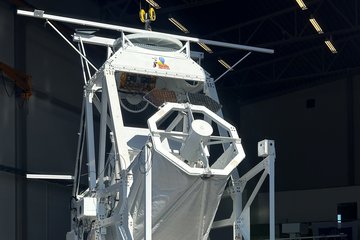All genres
1.
Journal Article
Updates to the SUMER Spectral Atlas. Solar Physics 297, p. 145 (2022)
2.
Journal Article
The Solar Orbiter SPICE instrument: An extreme UV imaging spectrometer. Astronomy and Astrophysics 642, A14 (2020)
3.
Journal Article
The Solar Orbiter EUI instrument: The Extreme Ultraviolet Imager. Astronomy and Astrophysics 642, A8 (2020)
4.
Journal Article
An Empirical Model of the Variation of the Solar Lyman-α Spectral Irradiance. Geophysical Research Letters 45 (5), pp. 2138 - 2144 (2018)
5.
Journal Article
Erratum: “Modeling the Chromosphere of a Sunspot and the Quiet Sun” (vol 811, 87, 2015). Astrophysical Journal 821 (1), 70 (2016)
6.
Journal Article
The atmosphere of Pluto as observed by New Horizons. Science 351, aaf8866 (2016)
7.
Journal Article
Solar coronal jets: Observations, theory, and modeling. Space Science Reviews 201 (1), pp. 1 - 53 (2016)
8.
Journal Article
Modeling the chromosphere of a sunspot and the quiet sun. Astrophysical Journal 811, pp. 87 - 103 (2015)
9.
Journal Article
Solar and galactic cosmic rays observed by SOHO. Central European Astrophysical Bulletin 39, pp. 109 - 118 (2015)
10.
Journal Article
On extreme-ultraviolet helium line intensity enhancement factors on the Sun. Astrophysical Journal 803, 66 (2015)
11.
Journal Article
Hydrogen Ly-α and Ly-β full Sun line profiles observed with SUMER/SOHO (1996-2009). Astronomy and Astrophysics 581, A26, pp. 1 - 7 (2015)
12.
Journal Article
Non-LTE modelling of prominence fine structures using hydrogen Lyman-line profiles. Astronomy and Astrophysics 577, A92 (2015)
13.
Journal Article
The Balmer lines of He II in the blue wing of the hydrogen Lyman alpha line observed in a quiescent prominence. Solar Physics 290, pp. 381 - 387 (2015)
14.
Journal Article
Scattered Lyman-alpha radiation of comet 2012/S1 (ISON) observed by SUMER/SOHO. Astronomy and Astrophysics 567, L1 (2014)
15.
Journal Article
The SUMER data in the SOHO archive. Solar Physics 289, pp. 2345 - 2376 (2014)
16.
Journal Article
Hot explosions in the cool atmosphere of the Sun. Science 346 (6207), 1255726 (2014)
17.
Journal Article
Molecular absorption in transition region spectral lines. Astronomy and Astrophysics 569, L7 (2014)
18.
Journal Article
SPICE EUV Spectrometer for the Solar Orbiter Mission. Proceedings of the SPIE 8862, p. 0F1 ‐ 0F15 (2013)
19.
Journal Article
Temperature dependence of ultraviolet line parameters in network and internetwork regions of the quiet Sun and coronal holes. Astronomy and Astrophysics 557, A126 (2013)
20.
Journal Article
Explosive events: swirling transition region jets. Solar Physics 280, pp. 417 - 424 (2012)











